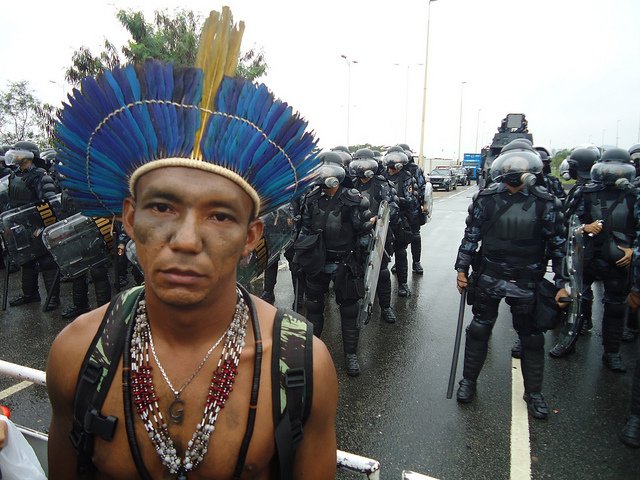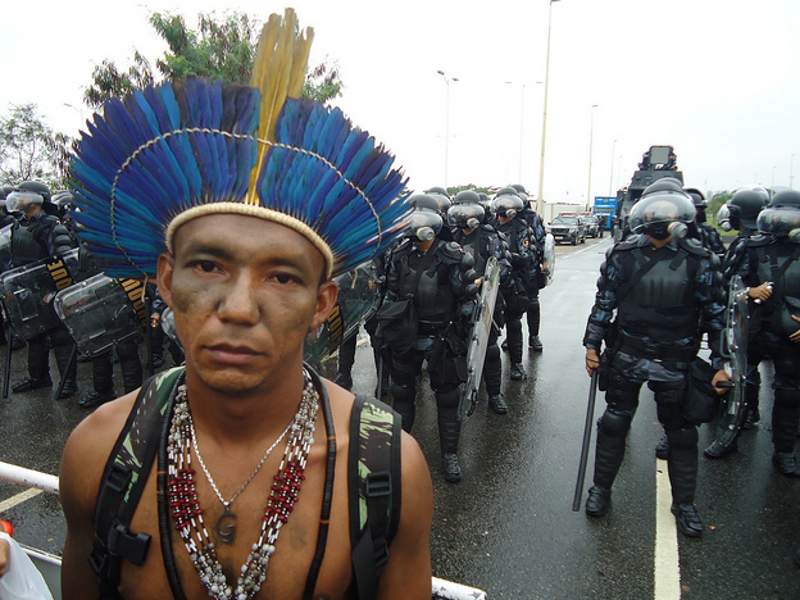
I wouldn’t call myself an avid soccer fan, but I’ve certainly been seduced by the World Cup (not to mention Tim Howard’s beard). As a result, I’ve been disturbed by reports about the environmental toll of the world’s most popular sporting event. I’ve also been struck by the fact that Brazil is today the most dangerous place in the world to be an environmental activist. By the end of Sunday’s final match, an estimated 3.7 million people will have flocked to Brazil to support their home teams. And if statistics hold true, at least two Brazilian environmental activists will have been murdered over the course of the tournament.
According to a report by Global Witness, an organization that works to expose the economic drivers behind conflict, corruption and environmental destruction, 908 environmental activists have been killed worldwide since 2002, which averages to one death every week. Since 2010, this rate has doubled to roughly two deaths a week. With 448 – or nearly half – of those deaths occurring in Brazil since 2002, the World Cup host is by and far the worst place to be an environmental activist.
Most of the assassinations of local activists and land defenders are triggered by disputes over land rights. The majority of the murders can be traced to increased exploitation of natural resources in remote corners of the world. As loggers, farmers, and miners move into new regions, Indigenous communities are especially likely to find themselves in conflict with corporate interests, as their land rights often go unrecognized by national governments.
In Brazil, deforestation has become a national problem, increasing by 28 percent between 2012 and 2013. It has also emerged as the biggest force behind land conflicts, pitting the notoriously corrupt logging industry against local communities deep in the Amazon. Brazil is particularly lax in enforcing logging restrictions, and even amended the national forest code in 2012 to provide greater amnesty for illegal logging. Loggers also often serve as “gateway” developers in remote regions, paving the way (sometimes literally) for large-scale agricultural interests and other commercial prospectors to move in. In Brazil, killings of local activists have been most highly concentrated in the regions with the heaviest deforestation.
Huge disparities in wealth and power don’t help the situation. “One of the main reasons that Brazil has such a high death toll is that land ownership is concentrated in more powerful elites with strong political and business connections,” says Alice Harrison, a communications advisor with Global Witness. “So that brings people into conflict with quite powerful economic interests.”
Maíra Irigaray, Brazil program coordinator with Amazon Watch, who has first hand experience working with Indigenous communities in the Amazon, agrees. “Whoever does this type of job is taking a risk. When you are fighting big corporations, or you are fighting government, or you are fighting mining and illegal logging, these people have their ambitions, they have their own way of operating, and there is so much money involved that one life means nothing.”
These challenges surrounding development and inequity are compounded by weak rule of law, particularly in remote regions of the Amazon that often lack basic phone and Internet connections. “I think it is very challenging for those who want to really fight for social justice and environmental rights… in the Amazon rainforest, where you are pretty much in the middle of nowhere. Whatever happens there stays there,” says Irigaray, speaking over the phone from Brazil. “Laws do not work the way they are supposed to in those places.”
And these challenges aren’t going to ease up – as competition for natural resources increases, it appears that they are getting worse. This makes the lack of legal enforcement and prosecution all the more problematic: For all 908 murders of environmental activists across the world since 2002, only 10 perpetrators have been tried and convicted. That is a one percent global conviction rate. What is more, these numbers don’t account for lesser acts of violence or threats against activists and their families, which are almost certainly more prevalent than assassinations.
As startling as these statistics are, one of the greatest challenges advocates face is the lack of monitoring and reporting surrounding environment-related murders. That means that Global Witness’ estimate of the number of killings is likely conservative, representing only those deaths that have been reported and confirmed. The report’s authors believe that Brazil’s high death rate actually reflects, at least in part, superior monitoring within the country. Many countries, including a large number of African nations, face significant resource-related stresses but are underrepresented in the report due to lack of field investigations.
Global Witness hopes their report will spark action among both government and corporate actors. The group is calling for greater enforcement of existing human rights safeguards, formal recognition of the unique challenges faced by environmental activists, and prompt and impartial investigations into violence against land defenders.
The sheer scale of environmental activist murders, as well as the impunity surrounding these killings, is eye opening. However, the deaths are also emblematic of a much broader issue: The lack of accountability surrounding global devastation of our natural resources. As Irigaray puts it, “This is not just related to one person in one specific area. It is related to this entire environmental lack of consciousness that we have as humanity as a whole… There are consequences to that. The Amazon rainforest is populated. There are people there, people who rely on the forest to survive. So it is a much broader issue than just environmental activists or Indigenous activists being killed. It is about the way the system works. That it doesn’t really work at all.”
Brazil did not hesitate to spend big for the World Cup, which it promoted as the “Copa Verde” (Green Cup). Hosting the event cost the nation an estimated $11.3 billion in public works spending alone. This included $3.6 billion on 12 new and refurbished stadiums, including the infamous $325 million Arena da Amazonas stadium in the middle of the Amazon rainforest (the US played Portugal there on June 22). If the Brazilian government spent even a fraction of this amount defending the land rights of the poor and disenfranchised, this South American powerhouse could probably shake its unfortunate distinction of being an unsafe place for environmental activists.














